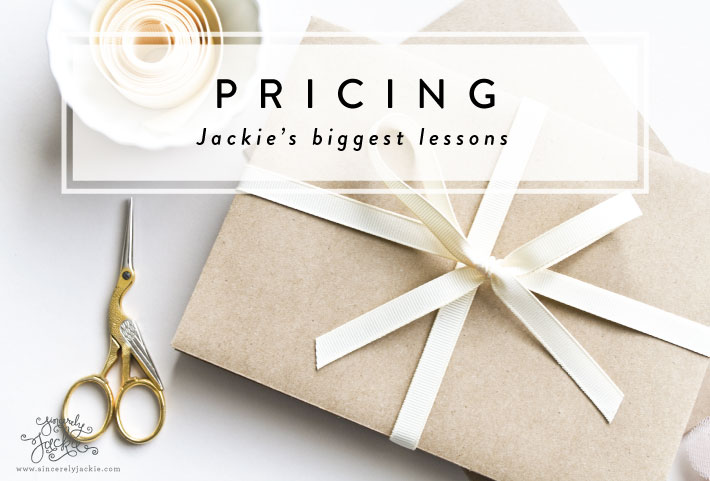Paper Cuts: Pricing Lessons Learned

I am by no means going to stand here and tell you that I know all the tricks and secrets about pricing. Truth be told, I probably struggling with nailing down my pricing strategy as much as you do. It's a tough line to walk, and we will each need to walk it a little differently.
That being said, I have learned some valuable lessons along the way, and I am happy to share them. Whether you're a seasoned business owner, or just starting to think about launching a business, I hope these tips will give you something to think about. (disclaimer, these tips are based on my own personal, business, and financial situations)
1: NEWBIES: It's OK to price low when you're starting out, and it's OK to double (triple, even) your prices once you've got things going a bit. You know the way new restaurants always come into neighborhoods with rock-bottom prices, and then six months later the prices go up? That's because they're taking the time to get to know their potential consumers, they're showing off their product at a price-point that's hard to say no to. They're hoping to WOW so many people in those first few months that they'll be able to boast rave reviews, have multiple features in newspapers, and have consumers come back over and over - even bringing their friends! The prices will quickly creep up, but, if the restaurant has done a good job, the clients won't bat an eyelash since they know the true value of what they're getting. Same goes for your business, it's OK to price yourself low when you're starting, as long as you know when and how to get your prices up with market value.
2: TRACK EVERYTHING: I keep a customer log that has every single cost that goes into every single customers order. I did not do this when I first started my business, and I always felt like I was unable to pin-point where my proceeds were going. Turns out, I was only charging clients based on my print and shipping costs. I wasn't including the costs for envelopes, packaging, and branding material that went into each order. Once I started tracking my actual cost per order, I was dumbfounded by how small my actual profit margin was.
3: CHARGE FRIENDS AND FAMILY: I had SUCH a hard time with this one. I always felt like it wasn't right for me to earn money off of people I loved. For a long, long time, I would simply pass my own costs to friends & family, but then I started tracking my expenses (see above!) and realized that I was losing a lot of money in my attempt to "help" loved ones. For example, if it cost me $100 for invitations & envelopes for my sister-in-law, I would simply charge her $100. However, I would still need to package her order in stationery boxes, add tissue paper, print an invoice, use ribbon to tie a bow, include a few business cards, and then pack it all up in a shipping box for easy carrying. Oh, and then there was sales tax and PayPal or credit card fees that I didn't tack on. Once I added in my actual costs, I was really spending between $120-$130, which meant I was losing a significant amount of money. It's ironic because loved ones were working with me so that they could support my business and help me grow. When I realized that I was losing money on these orders, I feared that loved ones would be UPSET with me for charging more. It was the opposite! Especially now that I've left my job, it seems those closest to me realize that I need to put bread on the table, and they're always happy to help me achieve that dream.
4: FIGURE OUT WHAT YOU NEED: When my business was still part-time, I wasn't as concerned with "making my numbers". I had a salary that paid the bills, and I used almost all of the money from my business to reinvest. All of that changed when I left my full-time job. I now need to earn enough to live off of. While that kind of growth may not happen over night, it means that over time I will either have to raise my prices, or work with a significantly larger number of clients per year. If there's a certain amount of money that you need to pay the mortgage, you'll have to figure out how many items you need to sell, and at what price. I know there is a whole train of thought where they say tracking numbers and goals are bad - well, once I'm doing so phenominally well that I don't have to worry about paying the mortgage, that's when I'll stop managing my workload and goals.
5: BE FLEXIBLE: I'm a sucker for people who are nice to me. If you flatter me, touch my heart, and make me feel good, there's a REALLY good chance that I'll do whatever I can to keep working with you. If it means I need to discount slightly, or get creative in what print methods or paper options we use in order to keep your budget, I'll go out of my way to try and do that. Shhh, don't tell anybody, ok?
6: RESENTMENT-FREE PRICING: When I started my business and was grossly undercharging for my work, I eventually found myself feeling bitter and resentful towards my clients. However, I knew it was my own fault for not charging what I knew my value to be. I was chatting with a friend about my resentment, and she asked me how much I would need to charge in order to feel THRILLED instead of resentful with each new client. I told her the number, and it surprisingly wasn't much more than I was already charging. So I updated my prices to be "resentment-free". Now, every time I get a client, I feel SO EXCITED about working with them, taking on their incredible vision, and putting in the hours and passion to create their stationery dreams. Resentment-free pricing also leaves enough room for me to be flexible when somebody genuinely compliments my hair or tells me I look thin in my jeans. Because again, if you make me feel awesome, I'll happily try to return the favor. Have you thought about what would your resentment-free pricing be?
So there you have it, my top lessons learned around pricing. I hope this was helpful for you! As always, if you have any questions or comments, I would love to hear them! And if you have any tips around pricing, please do share!
Sincerely,
